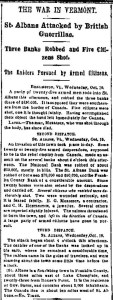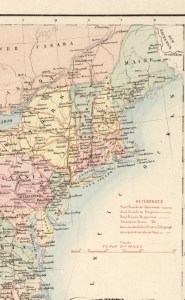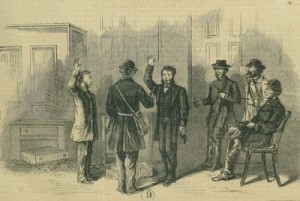150 years ago yesterday St. Albans, Vermont was “raided” by a band of Confederates led by Bennett Henderson Young. The rebels entered Vermont via Canada and took rooms in St. Albans’ hotels. On the 19th they held up three banks and shot up some citizens, one of whom died.
From the Richmond Daily Dispatch October 24, 1864:
An invasion of Vermont from the Canada side — robbery of banks — panic of the citizens.
The Yankees are having a sensation nearer home than the seat of war. On Wednesday last, a band of twenty-five men from Canada “invaded” the town of St. Albans, in Vermont, and robbed the National Bank of $50,000, the St. Albans Bank of $80,000, and the Franklin County Bank of a considerable sum. Some twenty horses were also seized by the desperadoes and carried off. Several citizens who resisted were deliberately shot; two were seriously wounded, and it is feared fatally — E. J. Morrison and, a contractor, and C. H. Huntington, a jeweler. Several others are reported slightly wounded. The attack commenced about 3 P. M., and the opening is thus described by an eye-witness:
Several men appeared to be rushing about with pistols, in parties of from five to ten. One of these gangs met a Mr. Morrison and presented a weapon to him, demanding his surrender. He answered, “You are joking, boys.” They fired and he fell, weltering in his blood. Our informant saw him throw up his hands and then sink on the ground, and then he realized for the first time that the village was attacked by an organized body of men, bent on pillage and regardless of human life.
Meanwhile the attack had been simultaneous on the three banks — the First National, Franklin County and St. Albans. Parties entered each. When the teller, or cashier, suspecting no evil, asked what they desired, the leader presented a pistol, with the exclamation, “You are my prisoner; if you move an inch we’ll blow you through,” Others of the gang then went to the vault and drawers and laid violent hands on all the specie, bills and other articles which they could find, and filled the side satchels, which each wore, as we before described. Of course resistance was useless, for the surprise was complete. At the Franklin County Bank the raiders pushed the cashier, Mr. Beardsley, and one of the clerks, into the vault and locked them up, and the prisoners were not released until late in the night.
Then commenced a reign of terror in the village. Plunder had been accomplished, and violence followed. The raid was brief; but the scene must have been terrible while it lasted. The thirty or more marauders rushed up and down the streets, firing their pistols in every direction. Whenever they saw a citizen or a group of men they would aim in that direction. They had magnificent arms–seven-shooters — and as fast as one weapon was unloaded they drew another, and kept up the lade.Mr. Baldwin says he can only liken the sounds to the noise of a Fourth of July morning in a large city. There was a continuous bang! bang! bang! Of course this reckless use of firearms could not continue long with nobody hurt. The sheriff of the county soon fell; Mr. Huntington was shot while resisting the robbery of his store; a woman, whose name we could not learn, fell, and — more dastardly than all — as the guerrillas were leaving the town, they saw a little girl in the street and wantonly killed her. And the bullets were flying around among the buildings in the main street — nearly all of which bear marks of lead. Windows were broken, blinds chipped and people wounded. It was a scene that beggars all description.
Of course the entire populace rushed into the streets. They had no idea of the cause of the disturbance, for they were engaged in their usual daily avocations, and the raid was “like thunder from a clear sky.” The guerrillas, as they rushed through the town, stopped all the citizens they met and gathered them in squads under guard of a few men, armed with pistols, retaining them as prisoners, on the common. Meanwhile the remainder of the banditti started to secure horses. They took two from Field’s livery stable, five from Fuller’s, several from the American and Tremont stables, and a twelve hundred dollar span from Mr. Clark, of Rutland — securing about thirty in all. Their adroitness in cutting off harness was marvellous, and the contents of the saddle-makers’ shops soon enabled the villains to become cavalry instead of footpads.
Meanwhile their threats were terrible. “We will burn your damned town,” they said. “We will treat you as the people of Atlanta were treated.”–They also said, “We are coming back again, and will burn every town in Vermont.” Their imprecations were of a blasphemous character. They claimed to be Confederates. Our informant does not think any of the men were Canadians. They all looked like Americans, and Southerners at that. These demons continued their infernal pistol-firing, killing a man named Morse after they began to “take prisoners.”
All this was the work of twenty minutes. Conductor Baldwin says he can scarcely realize that it all happened, and that so much was done in so short a time. The guerrillas, having all secured horses and saddles, commenced their retreat. They abandoned the prisoners and rode off northward, firing their pistols as they proceeded.
After the invaders had gone the citizens turned out and pursued them, capturing the leader, with $100,000. The Governor-General of Canada is also endeavoring to arrest those who escaped into that province. As the “raiders” passed through Frewsburg, an attempt was made to stop them, and the bailiff of the town was killed. All New England is crazy over this “barbarous invasion,” and is trying to prove that the men were Confederates.
You can read a complete account at The St. Albans Raid.
Although pursued by townspeople, the rebel band eventually made it back to Canada, where they were locked up. The United States’ request for extradition failed, and the detainees were released.



